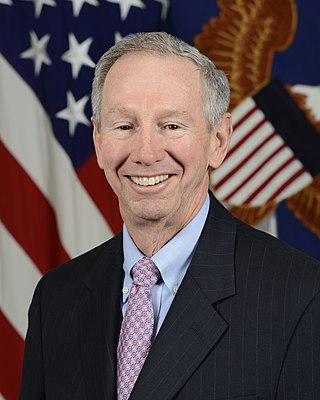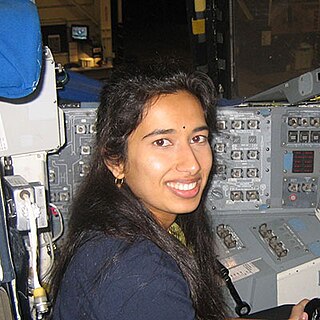
Spacecraft propulsion is any method used to accelerate spacecraft and artificial satellites. In-space propulsion exclusively deals with propulsion systems used in the vacuum of space and should not be confused with space launch or atmospheric entry.

Aerobraking is a spaceflight maneuver that reduces the high point of an elliptical orbit (apoapsis) by flying the vehicle through the atmosphere at the low point of the orbit (periapsis). The resulting drag slows the spacecraft. Aerobraking is used when a spacecraft requires a low orbit after arriving at a body with an atmosphere, as it requires less fuel than using propulsion to slow down.

The Mars Reconnaissance Orbiter (MRO) is a spacecraft designed to search for the existence of water on Mars and provide support for missions to Mars, as part of NASA's Mars Exploration Program. It was launched from Cape Canaveral on August 12, 2005, at 11:43 UTC and reached Mars on March 10, 2006, at 21:24 UTC. In November 2006, after six months of aerobraking, it entered its final science orbit and began its primary science phase.

George David Low was an American aerospace executive and a NASA astronaut. With undergraduate degrees in physics and mechanical engineering and a master's degree in aeronautics and astronautics, he worked in the Jet Propulsion Laboratory (JPL) at the California Institute of Technology in the early 80's, before being picked as an astronaut candidate by NASA in 1984. In addition to holding some technical assignments, he logged more than 700 hours in space, before he left NASA in 1996 to pursue a career in the private sector. He was the son of George M. Low, the manager of the Apollo Spacecraft Program Office, and later, the 14th president of Rensselaer Polytechnic Institute.

Michael Douglas Griffin is an American physicist and aerospace engineer who served as the Under Secretary of Defense for Research and Engineering from 2018 to 2020. He previously served as Deputy of Technology for the Strategic Defense Initiative, and as Administrator of NASA from April 13, 2005, to January 20, 2009. As NASA Administrator Griffin oversaw such areas as private spaceflight, future human spaceflight to Mars, and the fate of the Hubble telescope.
Space environment is a branch of astronautics, aerospace engineering and space physics that seeks to understand and address conditions existing in space that affect the design and operation of spacecraft. A related subject, space weather, deals with dynamic processes in the solar-terrestrial system that can give rise to effects on spacecraft, but that can also affect the atmosphere, ionosphere and geomagnetic field, giving rise to several other kinds of effects on human technologies.

Aerocapture is an orbital transfer maneuver in which a spacecraft uses aerodynamic drag force from a single pass through a planetary atmosphere to decelerate and achieve orbit insertion.
Jerome Pearson was an American engineer and space scientist best known for his work on space elevators, including a lunar space elevator. He was president of STAR, Inc., and has developed aircraft and spacecraft technology for the United States Air Force, DARPA, and NASA. He held several patents and was the author of nearly 100 publications in aircraft, spacecraft, electrodynamic tethers, SETI, and global climate control.
The University Nanosat Program is a satellite design and fabrication competition for universities. It is jointly administered by the Air Force Office of Scientific Research (AFOSR), the Air Force Research Laboratory (AFRL), the American Institute of Aeronautics and Astronautics (AIAA), the Space Development and Test Wing and the AFRL Space Vehicles Directorate's Spacecraft Technology division. NASA's Goddard Space Flight Center was involved from the program inception through Nanosat-3.

Robert David Braun is an American aerospace engineer and academic. He has served as the dean of the College of Engineering and Applied Science at the University of Colorado Boulder, the David and Andrew Lewis Professor of Space Technology at the Georgia Institute of Technology, and the NASA Chief Technologist. Currently, Dr. Braun is the Space Sector Head at the Johns Hopkins University Applied Physics Laboratory (APL).

David A. Spencer is the Mars Sample Return Campaign Mission Manager at the Jet Propulsion Laboratory. As an aerospace engineer, Spencer designs and operates planetary spacecraft.
George Henry Born was an American aerospace engineer, Distinguished Professor, founder and Director Emeritus of the Colorado Center for Astrodynamics Research (CCAR) at the University of Colorado Boulder. He is known for his work in satellite navigation and precise orbit determination. He worked on various missions while at the Jet Propulsion Laboratory as well as navigation support for the Apollo program in the late 1960s while at Johnson Space Center.

David W. Miller is an American aerospace engineer who is the current Jerome Hunsaker Professor of Aeronautics and Astronautics at Massachusetts Institute of Technology and an elected Fellow of the American Institute of Aeronautics and Astronautics since 2015. He is currently on a leave of absence from MIT to be a VP and the Chief Technology Officer to The Aerospace Corporation. He has worked on multiple NASA projects and served as NASA Chief Technologist.
The Tera-hertz Explorer (TEREX) mission is a planned orbiter and lander that will be carrying a terahertz sensor to the surface of Mars to measure the oxygen isotope ratios of various molecules in the Martian atmosphere. The objective of the mission is to understand the chain of chemical reactions that resupply the atmosphere with carbon dioxide.

James Michael Longuski is an American scientist, inventor, writer, and educator known for his contributions to astrodynamics and space mission design. He worked as a space mission designer at Jet Propulsion Laboratory (JPL) for NASA starting in 1979. Longuski joined the faculty at Purdue University School of Aeronautics and Astronautics in 1988 and served until after the fall semester 2023.

Powtawche N. Valerino is an American mechanical engineer at the NASA Jet Propulsion Laboratory. She worked as a navigation engineer for the Cassini mission.
The Ann and H.J. Smead Department of Aerospace Engineering Sciences is a department within the College of Engineering & Applied Science at the University of Colorado Boulder, providing aerospace education and research. Housed primarily in the Aerospace Engineering Sciences building on the university's East Campus in Boulder, it awards baccalaureate, masters, and PhD degrees, as well as certificates, graduating approximately 225 students annually. The Ann and H.J. Smead Department of Aerospace Engineering Sciences is ranked 10th in the nation in both undergraduate and graduate aerospace engineering education among public universities by US News & World Report.

Swati Mohan is an Indian-American aerospace engineer and was the Guidance and Controls Operations Lead on the NASA Mars 2020 mission.

David Y. Oh is an American spacecraft systems engineer and expert in electric propulsion. Dr. Oh currently works at the Jet Propulsion Laboratory (JPL) as the NASA Psyche mission chief engineer. Prior to this role he served as the Project Systems Engineering Manager for Psyche. He was also the cross-cutting phase lead and lead flight director for the NASA Mars Science Laboratory mission and was recognized in popular media for living on Mars time with his family during the month following the landing of the Curiosity rover.
Maruthi Ram Akella is an Indian-American aerospace engineer. Akella specializes in the control of complex dynamical systems that are subject to large scale nonlinearities and uncertainties.













